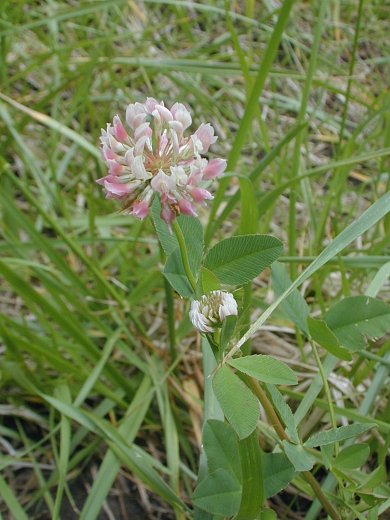Description: This herbaceous perennial plant is ½–2' tall, branching occasionally. The stems are round and hairless, or nearly so. Alternate compound leaves occur along these stems. They are trifoliate, and have long petioles. Where the petiole joins the stem, there are a pair of membranous stipules that are broadly lanceolate. The individual leaflets are about ½" long, and either oblong or obovate in shape. They are neither sharply pointed nor indented at their tips, while their margins are finely serrate. Unlike some Trifolium spp., there are no chevrons (white markings) on the upper surface of these leaflets. The foliage is hairless.

From the stipules
of the upper stems, there are flowering stalks that terminate in
well-rounded flowerheads about ½–¾" across. Each flower is about ¼"
long and very slender, consisting of a tubular corolla and 5 lobe-like
petals. Like other pea-like flowers, there is a standard, two side
petals, and a keel, but they are tubular and narrow. The calyx of each
flower is white with long slender teeth that are green. It is much
shorter than the corolla. The flowers are usually some shade of whitish
pink. The blooming period occurs intermittently during the summer for
1-3 months. The root system consists of a taproot and secondary roots
that form nodes with nitrogen-fixing bacteria.
Cultivation:
The preference is full or partial sun, and moist to mesic soil that is
slightly acidic. This plant flourishes in a loam or clay-loam soil.
Range & Habitat:
Alsike Clover is a common plant that occurs in every county of
Illinois. However, it appears to be less common than either Trifolium
pratense (Red Clover) and Trifolium repens
(White Clover). Alsike Clover was originally introduced into North
America from Europe,
probably for agricultural purposes. Typical habitats includes moist
meadows near woodlands, pastures, abandoned fields, and roadsides. It
does not tolerate regular lawn-mowing as well as White Clover.
Faunal
Associations: Long-tongued
bees
visit the flowers for pollen or nectar, including honeybees. Many kinds
of insects feed on the foliage, seeds, roots, and other parts of of
Alsike Clover (Trifolium hybridum) and other clover species (Trifolium
spp.). This includes such insects as Cerotoma trifurcata (Bean Leaf
Beetle) and other leaf beetles, Hypera punctata (Cloverleaf Weevil) and
other weevils, larvae of Agromyza frontella (Alfalfa Blotch Leafminer)
and other leaf-miner flies, larvae of Dasineura leguminicola (Clover
Seed Midge) and Dasineura trifolii (Clover Leaf Midge), Lygus
lineolaris (Tarnished Plant Bug) and other plant bugs, Euschistus
variolarius (One-spotted Stink Bug) and other stink bugs, Nearctaphis
bakeri (Clover Aphid) and other aphids, Aceratagallia sanguinolenta
(Clover Leafhopper) and other leafhoppers, Chnaurococcus trifolii
(Clover Root Mealybug) and other mealybugs, larvae of Caenurgina
crassiuscula (Clover Looper Moth) and other moths, Melanoplus
femurrubrum (Red-legged Grasshopper) and other grasshoppers, etc. In
addition, the caterpillars of some Sulphur butterflies (Colias spp.)
and the butterfly, Everes comyntas (Eastern Tailed Blue), feed on
clovers too
(see the Insect
Table
for a more complete list of these insects). Some vertebrate animals
also feed on Alsike Clover and other clover species. Such granivorous
songbirds as the Horned Lark, Chipping Sparrow, and Mourning Dove eat
the seeds, while the Canada Goose and such upland gamebirds as the
Ruffed Grouse, Wild Turkey, and Greater Prairie Chicken eat the leaves,
flowers, and/or seeds. Among mammals, domesticated livestock, deer,
rabbits, groundhogs, voles (Microtus spp.) eat the foliage of these
plants. In addition, the Thirteen-lined Ground Squirrel and American
Black Bear eat the leaves, flowerheads, and/or seeds (Martin et al.,
1951/1961; DeVore et al., 2004; Bellrose, 1942/1976; Lewis, 1993;
Romain et al., 2013).
Photographic Location:
The photograph was taken of a plant growing in a meadow near a woodland
in Judge Webber Park, Urbana, Illinois.
Comments:
While this is a weedy species, its value to wildlife is rather high.
Alsike Clover resembles Trifolium repens (White
Clover), except its leaves develop from the stems rather than from
runners in the ground, and there are no chevrons (white-markings) on
its leaflets. Alsike Clover is usually somewhat taller than White
Clover, and its flowerheads are usually more pinkish in appearance. It
differs from Trifolium pratense (Red Clover) in
being a smaller, less hairy plant, with smaller flowerheads that are
less reliably pink. Red Clover has chevrons on its leaflets, while
Alsike Clover doesn't.